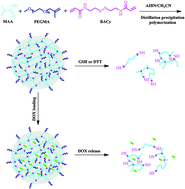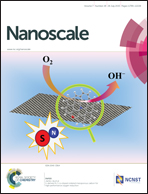Preparation of biodegradable PEGylated pH/reduction dual-stimuli responsive nanohydrogels for controlled release of an anti-cancer drug†
Abstract
A facile and efficient method was developed to prepare the monodisperse biodegradable PEGylated pH and reduction dual-stimuli sensitive poly[methacrylic acid-co-poly(ethylene glycol) methyl ether methacrylate-co-N,N-bis(acryloyl)cystamine] (PMPB) nanohydrogels with dried particle size below 200 nm via one-step distillation precipitation polymerization as a drug delivery system (DDS) for the controlled release of a wide-spectrum anti-cancer drug, doxorubicin hydrochloride (DOX). Under normal physiological media, the nanohydrogels possessed high drug encapsulation efficiency (more than 96%) within 48 h and exhibited good stability with a trifle premature drug release. However, rapid DOX release was achieved at lower pH or in the presence of reductive reagent glutathione (GSH) with a cumulative release of more than 85% within 30 h. Furthermore, the nanohydrogels manifested nontoxicity on HepG2 cells at a concentration of 10 μg mL−1 or lower. Based on the excellent characteristics of the nanohydrogels, such as low toxicity, impressive biodegradability, sharp dual responsiveness, adequate drug loading capacity and a high drug encapsulation efficiency, they were supposed to have potential application in the area of cancer therapy.


 Please wait while we load your content...
Please wait while we load your content...